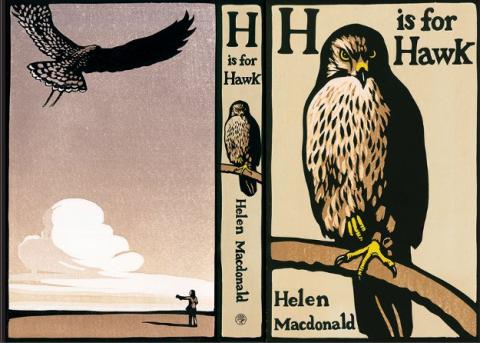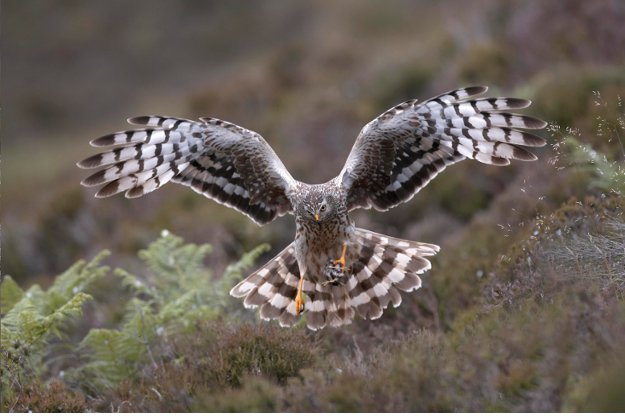Taming 30 Ounces of Death in Helen Macdonald’s ‘H is for Hawk’

H is for Hawk
By Helen Macdonald
Grove
300 pages
When her father died unexpectedly several years ago, the British naturalist, historian and academic Helen Macdonald was devastated. Unhinged by grief, she sought relief in an unusual activity--training a captive-bred goshawk from infancy to maturity. The result is H is for Hawk, one of the most striking memoirs to appear in recent years.
Macdonald, an experienced falconer, had never before taken on training a goshawk. The raptor’s notoriously difficult reputation was one factor, as was a distant memory from childhood, when as a 12-year-old girl intrigued by the ancient sport, she nagged her way into the company of a group of “clubbable men with battered Rovers and vowels that bespoke Eton and Oxford,” who were also masters of falconry. But even these men were beholden to their hawks’ fiercely wild nature, and when they released the birds into the air, not all of them came back:
“It seemed that the hawks couldn’t see us at all, that they’d slipped out of our world entirely and moved into another, wilder world from which humans had been utterly erased. These men knew they had vanished. Nothing could be done except to wait. So we left them behind: three solitary figures staring up into trees in the winter dusk, mist thickening in the fields around them, each trusting that the world would later right itself and their hawk would return.”
As an adult grieving the loss of her beloved father, Macdonald is drawn to goshawks—“thirty ounces of death in a feathered jacket.” Retreating from the human world, unable to conduct herself appropriately in social settings, she purchases a 10-week-old hawk in Scotland and returns to a solitary existence in Cambridge and begins a yearlong training regimen. In captivating prose, she recounts the early progress of her relationship with Mabel, as the hawk is named, realizing quickly that in order to bridge the gap between species, “one of the things you must do is to become invisible.” To bond with a creature of unyielding wildness, you must “empty your mind and become very still” and “think of exactly nothing at all.”
An uncommon, but for Macdonald, highly effective coping mechanism for grief.

H is for Hawk, however, is much more than an account of a woman’s grappling with the loss of a loved one (though a long passage early on describing “the time a kind of madness drifted in” will likely bring tears to your eyes). She writes wonderfully about the natural world in and around her home, “not an untouched wilderness like a mountaintop, but a ramshackle wildness in which people and the land have conspired to strangeness.” She’s also obsessed with the troubled life of T.H. White, best known as the man who wrote The Once and Future King, but more importantly for her, author of The Goshawk, a small masterpiece of falconry lore she first read as a child.
White sought refuge from the torments of childhood and undeclared homosexuality by training a goshawk of his own—except that his attempts ended in heartbreaking failure. Macdonald’s ongoing account of his valiant and misguided efforts opens up a suspenseful subplot extending throughout her book.
But what most intrigues Macdonald is Mabel’s unremitting wildness. Yes, the goshawk can be trained to fly and attack small prey and return to her fist, but she can never be domesticated, nor should she be:
“To me she was bright, vital, secure in her place in the world. Every tiny part of her was boiling with life, as if from a distance you could see a plume of steam around her, coiling and ascending and making everything around her slightly blurred, so she stood out in fierce, corporeal detail … The hawk was a fire that burned my hurts away. There could be no regret or mourning in her. No past or future. She lived in the present only, and that was my refuge. My flight from death was on her barred and beating wings.”
H is for Hawk demands to be read slowly, in order to savor the texture of emotions Macdonald so cunningly evokes, and for the simple joy of following one human being’s efforts to connect with a creature of the wild. At one point, she describes seeing a suitcase at an art gallery with a small round hole cut in the leather; inside the suitcase, the artist had attached “two acid-spotted mirrors” lit by tiny bulbs. Macdonald looks inside, “and there I was, a king of infinite space, dizzy, exhilarated, looking into a deep starfield that stretched into infinity.”
Reading H is for Hawk is a lot like staring into that box of stars. The pleasures go on forever.
Author Bio:
Lee Polevoi, Highbrow Magazine’s chief book critic, is author of a novel, The Moon in Deep Winter.






























































































































































































































































































































